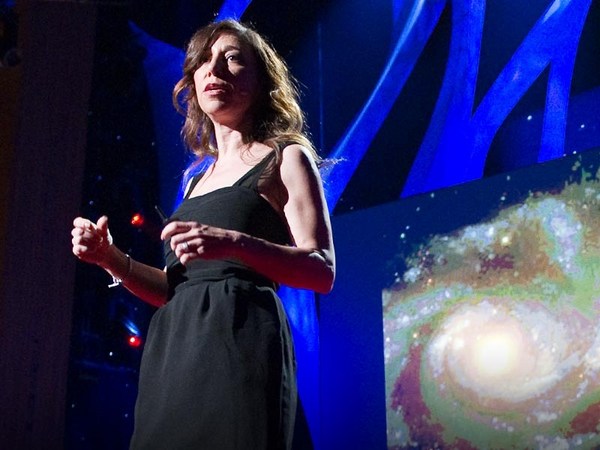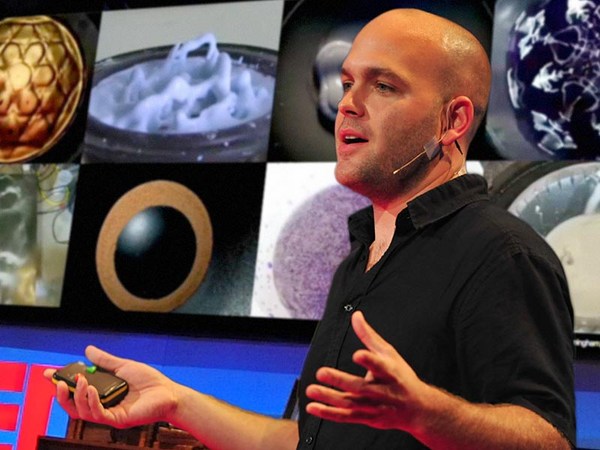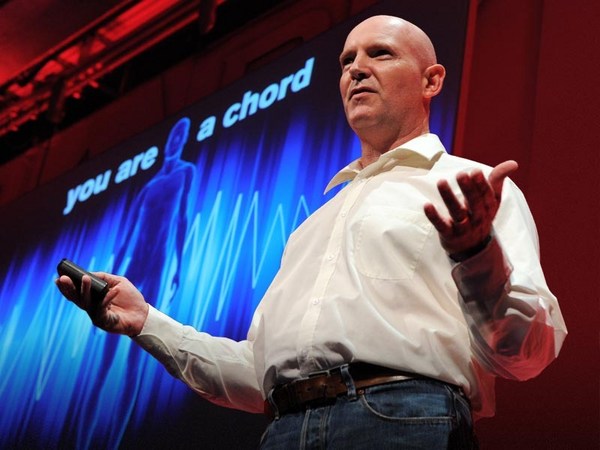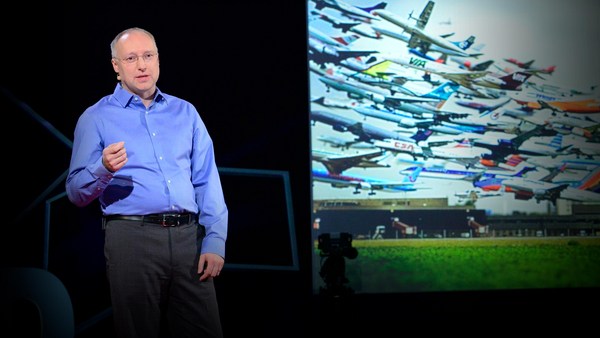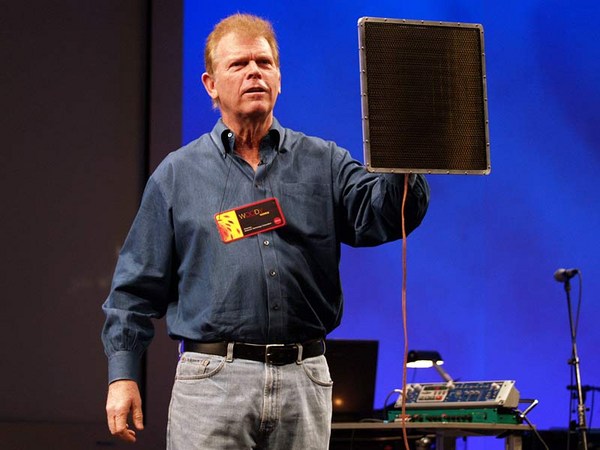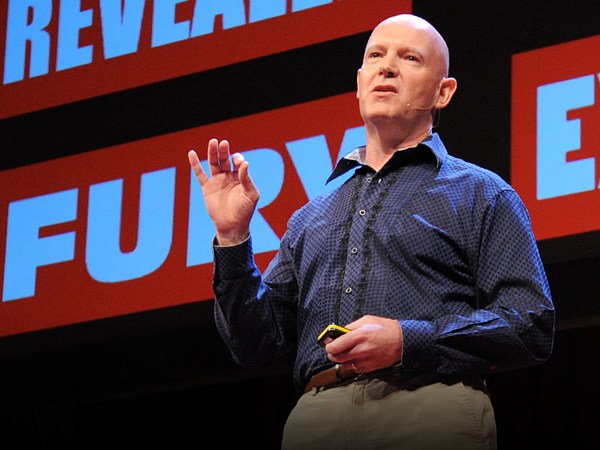Space, we all know what it looks like. We've been surrounded by images of space our whole lives, from the speculative images of science fiction to the inspirational visions of artists to the increasingly beautiful pictures made possible by complex technologies. But whilst we have an overwhelmingly vivid visual understanding of space, we have no sense of what space sounds like.
And indeed, most people associate space with silence. But the story of how we came to understand the universe is just as much a story of listening as it is by looking. And yet despite this, hardly any of us have ever heard space. How many of you here could describe the sound of a single planet or star? Well in case you've ever wondered, this is what the Sun sounds like.
(Static) (Crackling) (Static) (Crackling)
This is the planet Jupiter.
(Soft crackling)
And this is the space probe Cassini pirouetting through the ice rings of Saturn.
(Crackling)
This is a a highly condensed clump of neutral matter, spinning in the distant universe.
(Tapping)
So my artistic practice is all about listening to the weird and wonderful noises emitted by the magnificent celestial objects that make up our universe. And you may wonder, how do we know what these sounds are? How can we tell the difference between the sound of the Sun and the sound of a pulsar? Well the answer is the science of radio astronomy. Radio astronomers study radio waves from space using sensitive antennas and receivers, which give them precise information about what an astronomical object is and where it is in our night sky. And just like the signals that we send and receive here on Earth, we can convert these transmissions into sound using simple analog techniques. And therefore, it's through listening that we've come to uncover some of the universe's most important secrets -- its scale, what it's made of and even how old it is.
So today, I'm going to tell you a short story of the history of the universe through listening. It's punctuated by three quick anecdotes, which show how accidental encounters with strange noises gave us some of the most important information we have about space. Now this story doesn't start with vast telescopes or futuristic spacecraft, but a rather more humble technology -- and in fact, the very medium which gave us the telecommunications revolution that we're all part of today: the telephone.
It's 1876, it's in Boston, and this is Alexander Graham Bell who was working with Thomas Watson on the invention of the telephone. A key part of their technical set up was a half-mile long length of wire, which was thrown across the rooftops of several houses in Boston. The line carried the telephone signals that would later make Bell a household name. But like any long length of charged wire, it also inadvertently became an antenna. Thomas Watson spent hours listening to the strange crackles and hisses and chirps and whistles that his accidental antenna detected. Now you have to remember, this is 10 years before Heinrich Hertz proved the existence of radio waves -- 15 years before Nikola Tesla's four-tuned circuit -- nearly 20 years before Marconi's first broadcast. So Thomas Watson wasn't listening to us. We didn't have the technology to transmit.
So what were these strange noises? Watson was in fact listening to very low-frequency radio emissions caused by nature. Some of the crackles and pops were lightning, but the eerie whistles and curiously melodious chirps had a rather more exotic origin. Using the very first telephone, Watson was in fact dialed into the heavens. As he correctly guessed, some of these sounds were caused by activity on the surface of the Sun. It was a solar wind interacting with our ionosphere that he was listening to -- a phenomena which we can see at the extreme northern and southern latitudes of our planet as the aurora. So whilst inventing the technology that would usher in the telecommunications revolution, Watson had discovered that the star at the center of our solar system emitted powerful radio waves. He had accidentally been the first person to tune in to them.
Fast-forward 50 years, and Bell and Watson's technology has completely transformed global communications. But going from slinging some wire across rooftops in Boston to laying thousands and thousands of miles of cable on the Atlantic Ocean seabed is no easy matter. And so before long, Bell were looking to new technologies to optimize their revolution. Radio could carry sound without wires. But the medium is lossy -- it's subject to a lot of noise and interference. So Bell employed an engineer to study those noises, to try and find out where they came from, with a view towards building the perfect hardware codec, which would get rid of them so they could think about using radio for the purposes of telephony.
Most of the noises that the engineer, Karl Jansky, investigated were fairly prosaic in origin. They turned out to be lightning or sources of electrical power. But there was one persistent noise that Jansky couldn't identify, and it seemed to appear in his radio headset four minutes earlier each day. Now any astronomer will tell you, this is the telltale sign of something that doesn't originate from Earth. Jansky had made a historic discovery, that celestial objects could emit radio waves as well as light waves. Fifty years on from Watson's accidental encounter with the Sun, Jansky's careful listening ushered in a new age of space exploration: the radio astronomy age. Over the next few years, astronomers connected up their antennas to loudspeakers and learned about our radio sky, about Jupiter and the Sun, by listening.
Let's jump ahead again. It's 1964, and we're back at Bell Labs. And once again, two scientists have got a problem with noise. Arno Penzias and Robert Wilson were using the horn antenna at Bell's Holmdel laboratory to study the Milky Way with extraordinary precision. They were really listening to the galaxy in high fidelity. There was a glitch in their soundtrack. A mysterious persistent noise was disrupting their research. It was in the microwave range, and it appeared to be coming from all directions simultaneously. Now this didn't make any sense, and like any reasonable engineer or scientist, they assumed that the problem must be the technology itself, it must be the dish. There were pigeons roosting in the dish. And so perhaps once they cleaned up the pigeon droppings, get the disk kind of operational again, normal operations would resume.
But the noise didn't disappear. The mysterious noise that Penzias and Wilson were listening to turned out to be the oldest and most significant sound that anyone had ever heard. It was cosmic radiation left over from the very birth of the universe. This was the first experimental evidence that the Big Bang existed and the universe was born at a precise moment some 14.7 billion years ago. So our story ends at the beginning -- the beginning of all things, the Big Bang. This is the noise that Penzias and Wilson heard -- the oldest sound that you're ever going to hear, the cosmic microwave background radiation left over from the Big Bang.
(Fuzz)
Thanks.
(Applause)
